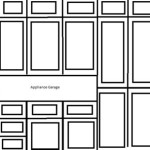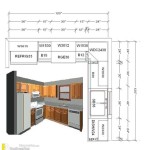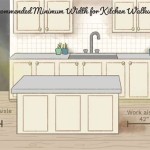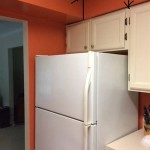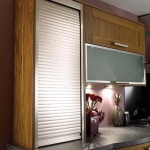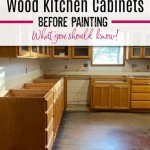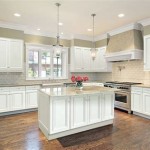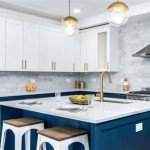Best Paints for Kitchen Cabinets: A Comprehensive Guide
Kitchen cabinets, often the focal point of the kitchen, are subject to considerable wear and tear. Choosing the correct paint for these surfaces is essential for achieving a durable, aesthetically pleasing, and long-lasting finish. This article provides an in-depth exploration of the best paint types for kitchen cabinets, covering their attributes, application guidelines, and factors to consider when making a selection. Understanding these nuances allows homeowners and professionals alike to make informed decisions, ensuring a professional and resilient outcome.
Understanding the Demands Placed on Kitchen Cabinet Paint
The kitchen environment presents unique challenges for painted surfaces. Cabinets are constantly exposed to moisture from cooking, cleaning, and dishwashing. Grease splatters, food stains, and frequent handling also contribute to the potential for wear and tear. A superior cabinet paint must therefore possess several key properties:
Durability: The paint should resist chipping, scratching, and peeling, maintaining its integrity even with daily use.
Washability: The painted surface needs to be easily cleaned with water and mild detergents, removing stains and grime without damaging the finish.
Moisture Resistance: The paint must be impervious to moisture, preventing warping, swelling, and mildew growth on the cabinet material.
Adhesion: The paint needs to adhere effectively to the cabinet surface, whether it is wood, laminate, or metal. Proper preparation is crucial for optimal adhesion.
Appearance: The paint should provide a smooth, even finish, enhancing the overall aesthetic appeal of the kitchen. Available color options and sheen levels influence the final result.
Top Paint Types for Kitchen Cabinets
Several paint types are well-suited for kitchen cabinets, each offering distinct advantages and disadvantages. The following are among the most popular and effective choices:
Alkyd Paint: Alkyd paint, also known as oil-based paint, has historically been a popular choice for cabinets due to its durability and smooth, enamel-like finish. Alkyd paints offer excellent adhesion, hardness, and resistance to stains and scratches. They level well during application, minimizing brushstrokes and creating a professional-looking result.
However, alkyd paints have several drawbacks. They emit strong fumes during application and drying, requiring adequate ventilation. The drying time is significantly longer compared to water-based paints, and cleanup requires paint thinner or mineral spirits. Furthermore, alkyd paints tend to yellow over time, particularly in areas exposed to sunlight. Due to environmental concerns and the availability of improved water-based alternatives, alkyd paint use has diminished, but it remains a viable option for specific applications where its durability is paramount.
Latex Paint: Latex paint, a water-based option, is increasingly favored for kitchen cabinets due to its low odor, ease of application, and quick drying time. Latex paints are available in a wide range of colors and sheens, providing ample design flexibility. Cleanup is simple, requiring only soap and water. While traditional latex paints may not have been as durable as alkyd paints, advancements in paint technology have led to the development of high-quality acrylic latex paints that rival the performance of oil-based options.
Acrylic latex paints offer improved adhesion, durability, and resistance to chipping and scratching. They are also less prone to yellowing than alkyd paints and are more environmentally friendly. When selecting a latex paint for cabinets, it is crucial to choose a product specifically formulated for trim and cabinets, as these paints are designed to withstand the demands of high-touch surfaces. Self-leveling properties are also desirable, ensuring a smooth, uniform finish.
Acrylic Enamel Paint: Acrylic enamel paint combines the benefits of both acrylic and enamel formulations. It provides a hard, durable, and washable finish that is ideal for kitchen cabinets. Acrylic enamel paints offer excellent adhesion to a variety of surfaces, including wood, laminate, and metal. They are also resistant to chipping, scratching, and stains, making them well-suited for the challenging kitchen environment.
These paints are water-based, resulting in low odor and easy cleanup. They dry to a smooth, glossy finish that resembles traditional enamel paints but without the drawbacks of oil-based formulations, such as strong fumes and long drying times. Acrylic enamel paints are available in a range of colors and sheens, providing versatility for various design preferences. They are often a preferred choice for homeowners seeking a durable, easy-to-maintain, and aesthetically pleasing finish for their kitchen cabinets.
Chalk Paint: Chalk paint is a decorative paint known for its matte finish and ability to adhere to various surfaces with minimal preparation. While not traditionally used for kitchen cabinets due to its porous nature, chalk paint can be a viable option when sealed with a durable topcoat, such as wax or a water-based sealant.
The primary advantage of chalk paint is its ease of use and ability to create a distressed or vintage look. It requires little to no sanding or priming on most surfaces, making it a time-saving option. However, the unsealed chalk paint finish is highly susceptible to staining, scratching, and moisture damage. Therefore, a high-quality topcoat is essential to protect the painted surface and ensure its durability in the kitchen environment. While chalk paint offers a unique aesthetic, it may not be the most practical choice for homeowners seeking a low-maintenance and long-lasting finish.
Specialty Cabinet Paints: Several paint manufacturers offer specialty paints specifically formulated for kitchen cabinets. These paints often incorporate advanced technologies to enhance adhesion, durability, and stain resistance. They may include features such as self-priming properties, built-in antimicrobial agents, and enhanced leveling capabilities.
Specialty cabinet paints are often more expensive than traditional paint options, but they can provide superior performance and longevity. They are typically available in a range of colors and sheens, allowing homeowners to achieve their desired aesthetic. When considering specialty cabinet paints, it is essential to research the specific product and its intended use, ensuring that it meets the requirements of the kitchen environment.
Preparing Kitchen Cabinets for Painting
Proper preparation is crucial for achieving a professional and durable paint finish on kitchen cabinets. The following steps outline the essential preparation process:
Cleaning: Thoroughly clean the cabinets with a degreasing cleaner to remove grease, grime, and dirt. This step is essential for ensuring proper paint adhesion. Rinse the cabinets with clean water and allow them to dry completely.
Removing Hardware: Remove all cabinet hardware, such as knobs, pulls, and hinges. This will prevent paint from getting on the hardware and allow for a cleaner, more professional finish. Label the hardware and store it in a safe place for reinstallation.
Sanding: Sand the cabinet surfaces to create a slightly rough texture, which will improve paint adhesion. Use medium-grit sandpaper (120-180 grit) for the initial sanding and fine-grit sandpaper (220 grit) for smoothing out any imperfections. Sand lightly and evenly, avoiding excessive pressure. For laminate or glossy surfaces, consider using a deglosser to dull the finish.
Priming: Apply a primer to the cabinets to create a uniform surface for the paint to adhere to. Primer also helps to block stains and tannins from bleeding through the paint, particularly on wood cabinets. Choose a primer that is compatible with the paint type you will be using. Apply the primer in thin, even coats and allow it to dry completely before painting.
Repairing Imperfections: Fill any holes, cracks, or dents with wood filler or spackle. Allow the filler to dry completely and sand it smooth to blend with the surrounding surface. This step will ensure a smooth and flawless paint finish.
Taping: Use painter's tape to protect adjacent surfaces, such as walls, countertops, and flooring. This will prevent paint from getting on these surfaces and create clean, crisp lines.
Application Techniques and Considerations
The application technique also significantly impacts the final appearance and durability of the painted cabinets. Several factors need to be considered during the application process:
Brush vs. Roller vs. Sprayer: The choice between a brush, roller, or sprayer depends on the desired finish, the size and complexity of the cabinets, and the homeowner's experience. Brushes are suitable for detail work and small areas, while rollers are ideal for covering large, flat surfaces. Sprayers provide the smoothest, most even finish, but they require more skill and preparation. Airless sprayers are commonly used for larger projects.
Number of Coats: Apply at least two coats of paint to the cabinets, allowing each coat to dry completely before applying the next. Multiple coats provide better coverage, durability, and color saturation. Follow the manufacturer's recommendations for drying times and recoating intervals.
Sheen Level: The sheen level of the paint affects the appearance and durability of the painted surface. Higher sheen levels (e.g., semi-gloss, gloss) are more durable and easier to clean, but they also highlight imperfections. Lower sheen levels (e.g., matte, eggshell) provide a softer, more subtle look but may be less durable and harder to clean. A satin or semi-gloss finish is often recommended for kitchen cabinets, balancing durability and aesthetics.
Environmental Conditions: Paint in a well-ventilated area with moderate temperature and humidity. Extreme temperatures or humidity can affect the drying time and adhesion of the paint. Avoid painting in direct sunlight or in temperatures below the manufacturer's recommended range.
Curing Time: Allow the painted cabinets to cure completely before reassembling and using them. Curing time varies depending on the paint type and environmental conditions but is typically several days to a week. During the curing period, avoid excessive handling or cleaning of the painted surfaces.
Maintaining and Cleaning Painted Cabinets: Regular cleaning and maintenance will prolong the lifespan of the painted cabinets. Clean the cabinets with a soft cloth and mild detergent, avoiding abrasive cleaners or scrub brushes. Wipe up spills and splatters promptly to prevent staining. Touch up any chips or scratches with matching paint to maintain the integrity of the finish.
Key Factors to Consider When Choosing Cabinet Paint
Selecting the best paint for kitchen cabinets involves considering several key factors to ensure the chosen product meets specific needs and expectations. These factors include durability, ease of application, aesthetics, and budget. By carefully evaluating these aspects, homeowners can confidently choose a paint that will enhance the beauty and longevity of their kitchen cabinets.
Durability and Washability: For high-use areas like kitchens, prioritising durability and washability is paramount. The paint should withstand frequent cleaning without losing its color or finish. Acrylic enamel and certain latex paints are known for their resilience and ability to be cleaned easily, making them suitable choices for kitchen cabinets.
Aesthetics and Finish: The desired aesthetic plays a significant role in selecting the right paint. Consider the overall design of the kitchen and the desired finish, whether it's a glossy, smooth look or a matte, textured appearance. Different paint types offer varying levels of sheen and texture, catering to diverse design preferences. Color selection is also crucial, ensuring that the chosen paint complements the kitchen's existing color scheme and style.
Ease of Application and Drying Time: The ease of application and drying time can significantly impact the project timeline and overall experience. Water-based paints, such as latex and acrylic enamel, typically offer easier application and faster drying times compared to oil-based paints. This can be a deciding factor for DIY projects or when time is a constraint. Additionally, paints with self-priming properties can streamline the preparation process, saving time and effort.

Best Paint Color For Kitchen Cabinets

Best Paint For Kitchen Cabinets Solved Bob Vila

The Best Paint For Your Cabinets 7 Options Tested In Real Kitchens

How To Paint Kitchen Cabinets Best Color Ideas Cost

The Best Kitchen Cabinet Paint Brand Honest Review

Cabinet Paint Explained The Best For Cabinets Arinsolangeathome

Pro Tips For Painting Cabinets In Your Home Paintzen

70 Top Kitchen Paint Colors Best 2024

Best Paint For Cabinets Types Of Kitchen

The Best White Paint For Kitchen Cabinets Color Concierge
Related Posts

